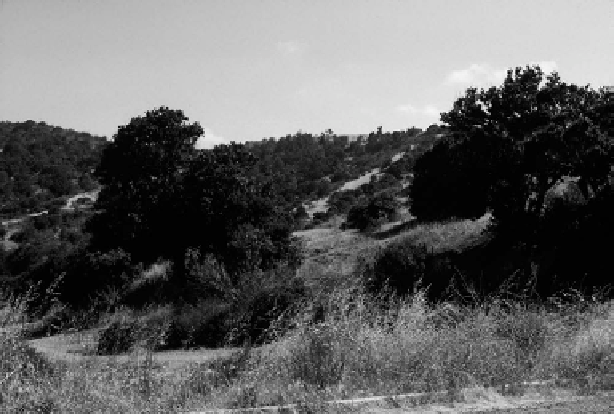Agriculture Reference
In-Depth Information
Fig. 6.3
Cryptocarya alba
woodland in central Chile. (Photo by Jon Keeley.)
Sclerophyll woodland (
bosque esclero´filo
) is widespread locally on mesic pole-
facing slopes of the Coastal Cordillera and in moist valleys (San Martin
2005
).
Common trees or tree-like shrubs include
Quillaja saponaria
,
Cryptocarya alba
(
Fig. 6.3
),
Lithraea caustica
,
Beilschmiedia miersii
and
Peumus boldus
(
Table 6.1
)
These stands can reach 10-15 m or more in height. On mesic sites these forests
have been termed hygrophilous forest, with species more characteristic of austral
forest to the south, such as
Aextoxicon punctatum
,
Aristotelia chilensis
,
Crinoden-
dron patagua
,
Persea lingue
, and
Drimys winteri
.
An open savanna community known as
espinal
covers low-lying areas of
the Central Valley (
Fig. 6.4
) and eastern slopes of the Coastal Cordillera
(
secano interior
)fromabout32
S in the north to the Laja River valley in the
south at 36
S (Ovalle
et al.
1990
; Fuentes
et al.
1990
). This community largely
owes its origin to historical opening of matorral and sclerophyll woodland
vegetation by fire, woodcutting and cattle grazing, leading to an open savanna
of
Acacia caven
in a matrix of alien annual grassland (Bahre
1979
; Fuentes
et al.
1989
).
Unlike the situation in California and the Mediterranean Basin where
evergreen shrublands give way to coniferous forests above about 1200-1500 m
elevation, forests are largely lacking from much of the Andean Cordillera
in central Chile. Only in the southern portions of central Chile does forest
vegetation begin to occur. For most of the central and northern Andean
slopes of the region, matorral gives way at these elevations to a low and open
evergreen shrubland termed montane matorral. This community extends
to elevations of about 2000-2200 m where it is replaced by subalpine and
alpine communities of cushion plants and low herbaceous perennials (Armesto
et al.
1980
).

